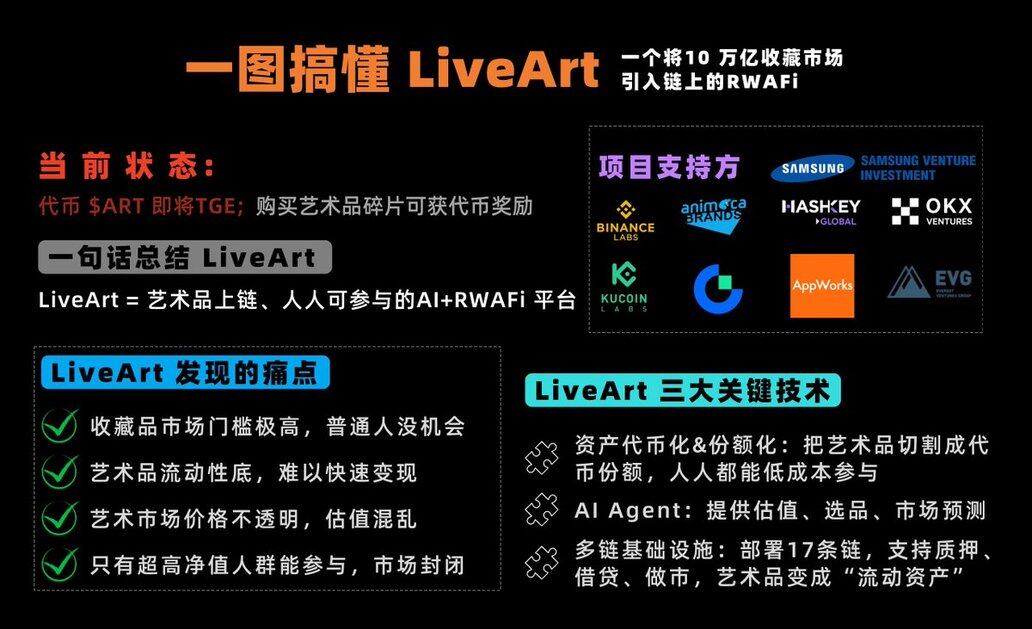It seems that the altcoin season has really arrived. Last week, I analyzed three coins, and they all had gains of about 50-100%.
The project that received the most criticism from me last time, $art, is up 80% today, and $AVNT is up 100% today.

LiveArt launched its token on September 9, and at that time, many people thought it was just a rehash of NFT hype, so many missed the airdrop, which they will likely regret.
🔸 Today, let's break down LiveArt and see how this RWA focused on bringing artworks on-chain can introduce the $100 trillion collectibles market to the blockchain.
In summary: LiveArt is a project that slices Picasso and puts it into the DeFi financial supermarket (Picasso sliced + DeFi financial supermarket).
When it comes to "art on-chain," many people's first reaction is NFT. But LiveArt is fundamentally different from NFTs.
✅ 1. The difference between LiveArt and NFT
🔹 NFT: More about JPGs, avatars, digital art, with value relying on speculation and community consensus; hot today, cold tomorrow, with no physical backing.
🔹 LiveArt: Backed by real assets like Picasso, Rolex, fine wine, and luxury cars, which are hard assets in the real world and appreciate over time.
👉 In simple terms: NFTs sell "virtual collectibles," while LiveArt sells "fragments of real art assets." In other words, [NFTs rely on speculation, while LiveArt relies on physical value].
In the brief introduction of LiveArt above, a key term mentioned repeatedly is "fragments of art assets." LiveArt achieves this through "asset tokenization" + "fractionalization," mapping offline assets to the blockchain and then splitting them into pieces, allowing ordinary people to participate in the collectibles market through AI + DeFi.
✅ 2. Basic motivation for participating in LiveArt (core value of the project)
In traditional markets, collectibles (like artworks, luxury watches, fine wine) have always been investment tools for the wealthy. The reason is simple: they are scarce, carry cultural value, and historically outperform most financial products, with average annual returns of 15%–23%.
But the problem is: the art market has a very high entry barrier; a Picasso painting can cost millions of dollars, making it inaccessible for ordinary people.
The emergence of LiveArt breaks this barrier. It fractionalizes collectibles (Shards), slicing them into small portions like splitting stocks. What only the wealthy could buy outright can now be owned for just a few dozen dollars.
When the offline artwork itself appreciates, the small portion you hold will also appreciate in value.
In other words, you don’t need to become a billionaire to share in the dividends of "long-term appreciation of collectibles."
👉 Therefore, the most basic motivation for retail investors to participate in LiveArt is to enter a market that was previously exclusive to the wealthy at a low cost and profit from the appreciation of the collectibles themselves.
This is also the ultimate goal of LiveArt: to move the $100 trillion art market, which was originally confined to the wealthy, onto the blockchain, transforming it into a new financial market that everyone can participate in.
In addition to the appreciation of collectibles leading to the appreciation of shares, LiveArt also introduces DeFi derivative yields, making Web3 more engaging.
How does it do this? Let’s take a look:
✅ 3. How does LiveArt DeFi-ify artworks?
This is LiveArt's "magic" (technology), simply put, it involves three steps:
🔹 Step 1: Slice → Tokenize
A painting is divided into many shares, and everyone can buy a little bit.
🔹 Step 2: On-chain → Tradable
These shares can be traded on the LiveArt market or DEX, allowing for immediate liquidity without waiting for auctions.
🔹 Step 3: Integrate DeFi → Financialize
Art tokens can be staked, borrowed, and placed in vaults to earn yields, even market-making to earn fees.
👉 This allows artworks to become tradable and stakable assets like Bitcoin for the first time, rather than just sitting idle in vaults.
✅ 4. What technologies does LiveArt use?
LiveArt is not just "randomly issuing an art token" or simply "moving artworks on-chain," but rather employs a combination of [tokenization/AI/multi-chain/custodial technology]:
1⃣ Asset tokenization & fractionalization
Breaking down an artwork worth millions of dollars into countless tokens (Shards). You only need a few dozen dollars to buy "a small piece of ownership" of that painting.
2⃣ AI Agent pricing & recommendations
LiveArt builds a multi-million art trading database, using AI algorithms to price artworks and recommend potential targets, avoiding the pitfalls of speculative trading.
3⃣ Multi-chain DeFi liquidity
Already deployed on 17 blockchains (Ethereum, BNB, Base, Linea, etc.), the art shares users buy can not only be held but also staked, borrowed, and traded flexibly like stablecoins.
4⃣ Secure custody + compliance assurance
Artworks will be stored in global Freeports (vaults) with insurance to ensure physical safety; the company is registered in Switzerland, backed by top-tier venture capital.
✅ 5. The collectibles market and projects that have been successfully implemented
According to public data, the collectibles market has already reached the following scale:
🔹 $100 trillion market: The traditional art and luxury goods market is enormous.
🔹 Stable returns: Blue-chip artworks have historical annual returns of 15–23%.
🔹 Real pain points: High entry barriers, poor liquidity, and opaque valuations.
🔹 On-chain opportunities: By 2025, the total amount of RWA tokenization has exceeded $26 billion, with only a few projects touching the art sector.
To understand how large the Web3 collectibles sector is, we can look at MasterWorks, which has already proven the model:
MasterWorks is an American art investment platform that fractionalizes artworks under traditional financial regulations, issuing them as securities. Users can buy shares of a painting just like buying stocks (not on-chain).
Currently, its assets under management (AUM) have exceeded $1.5 billion, indicating that the "fractionalization of artworks" model has been validated in traditional finance (TradFi). As an investment, artworks are indeed something people are willing to buy and can make money from.
However, because MasterWorks shares are securities, they cannot be freely traded like cryptocurrencies. Without an on-chain secondary market, users typically have to wait until the artwork is sold to realize their profits. Although it is cheaper than buying a painting outright, the platform mainly targets accredited investors in the U.S. (with income/asset thresholds).
🔸 LiveArt can be seen as a "Web3 upgrade" of MasterWorks:
🔹 LiveArt's shares are not securities but tokens that can be traded anytime like cryptocurrencies;
🔹 Strong liquidity: On the LiveArt self-built market and DEX, art tokens can be bought, sold, staked, and borrowed at any time.
🔹 Global access: No geographical or accredited investor restrictions; anyone with a wallet can participate.
🔹 AI support: Using AI data models for valuation and recommendations, not relying on traditional auction houses or brokers.
🔹 Token economy: Connecting the ecosystem through $ART, providing governance, incentives, and exclusive rights, which MasterWorks completely lacks.
🔸 In summary:
MasterWorks has validated the "fractionalization of artworks" model but has not gone on-chain, making it essentially inaccessible to global users; LiveArt brings collectibles on-chain through "asset tokenization" and "fractionalization" to create RWA, addressing the liquidity issues of collectibles through AI + DeFi. It transforms the art market from the "collection room" of the wealthy into a "chain-based financial supermarket" that everyone can participate in. This is not just RWA, but RWAFi.

22.2K
0
The content on this page is provided by third parties. Unless otherwise stated, OKX is not the author of the cited article(s) and does not claim any copyright in the materials. The content is provided for informational purposes only and does not represent the views of OKX. It is not intended to be an endorsement of any kind and should not be considered investment advice or a solicitation to buy or sell digital assets. To the extent generative AI is utilized to provide summaries or other information, such AI generated content may be inaccurate or inconsistent. Please read the linked article for more details and information. OKX is not responsible for content hosted on third party sites. Digital asset holdings, including stablecoins and NFTs, involve a high degree of risk and can fluctuate greatly. You should carefully consider whether trading or holding digital assets is suitable for you in light of your financial condition.

